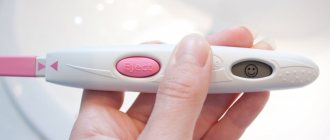Today, manufacturers offer a huge selection of home rapid pregnancy tests, which allow you to find out about the position 7-10 days after conception. Such early diagnosis and accuracy are ensured by the reagents with which the test strips are impregnated. However, sometimes it is difficult to distinguish a reliable strip from a reagent, and the result may be interpreted incorrectly.
Many women even post photos of their tests on forums and ask to evaluate the results, but in this case it would be much more effective to purchase a better test and take a blood test.
How does a pregnancy test work?
Pregnancy tests are sensitive stickers impregnated with a special reagent, which, if a woman has a hormone secreted during pregnancy in her urine, responds with the appearance of a second red stripe. This hormone (hCG) is produced 6-8 days after fertilization and its concentration in the blood and urine increases exponentially, which indicates a normally developing pregnancy.
This fact also explains the difference in the tones of the 2nd strip in the tests, which can be very weak at first, and then become bright red. In the absence of pregnancy, the hCG level in a woman’s blood does not exceed 5 mIU/ml and tests do not react to it in any way.
The principle of operation of the reagent in tests
Express tests vary in modifications and prices.
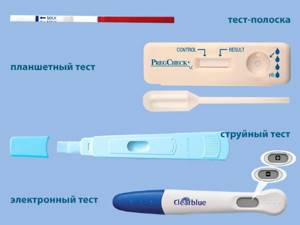
There are these types:
- strip strip;
- jet;
- tablet.
The reagent on a pregnancy test (photos of a false positive result are presented in the article for clarity) most often appears on cheap test strips, the production of which uses a cheap chemical reagent.
For each type of test, the manufacturer provides instructions for use, violation of which may also result in incorrect results.
Strip strip
1st generation products include strip tests produced in the form of strips. They are intended for independent individual use and obtaining quick results. In terms of cost, such tests can be either very cheap (for example Itest) or more expensive (Evitest, Frautest). Strip tests are paper-plastic strips that have an inner layer impregnated with a reagent. Upon contact with urine in a certain area, 2 vertical lines appear on the strip.
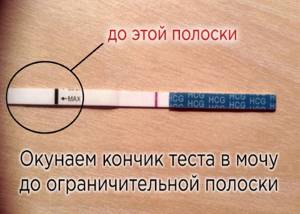
One of them confirms the validity of the test and always appears if the reagent is of high quality and the procedure was carried out according to the instructions. The appearance of the 2nd line just depends on whether the woman is pregnant or not, and whether the hormone hCG (human chorionic gonadotropin - secreted by chorionic tissue 6-8 days after embryo implantation) is present in the blood. If vertical lines do not appear on the test at all (and this also happens), this indicates that the product may be expired or the reagent in it has been destroyed for some reason (external influence, manufacturing defect).
The reagent on a pregnancy test, a photo of which can be shown to the gynecologist if questions arise, most often appears on simple test strips, especially those from the cheap price category. Such stripes resemble a “ghost” and often mislead girls and women. Also, a fuzzy reagent strip can often appear when even expensive and high-quality tests are used incorrectly.
To get a reliable result when using test strips, you should follow some rules prescribed in the manufacturers' instructions:
- the maximum concentration of the hCG hormone is observed in the first morning urine, which is what needs to be collected to obtain the most reliable analysis;
- before collecting urine, hygiene procedures should be carried out, since non-compliance with hygiene can distort the results;
- the container for collecting urine must be clean;
- The test strip should be immersed in the biomaterial strictly to the mark indicated on the test, and kept in it for the amount of time specified by the manufacturer (usually 20-30 seconds);
- after this, the test should be placed horizontally on a clean and dry surface;
- Results can be assessed after 1-10 minutes; the specific time depends on the manufacturer and the sensitivity of the test.
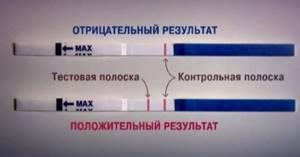
You should also know that the intensity of coloring of the control strip depends on the gestational age - the longer it is, the brighter the second stripe will be, and vice versa.
Tablet
This option is a strip with a reagent, which is placed in a plastic tablet with two windows, into one of which a few drops of urine are introduced using a pipette. After a few minutes, the result will be visible in another window - depending on the manufacturer, it can be either two red lines or stripes, or a plus or minus sign. The operating principle of tablet-type tests is the same as strip strips - when a certain part of the test containing the reagent interacts with urine, a chemical reaction occurs and the level of the hCG hormone is determined.
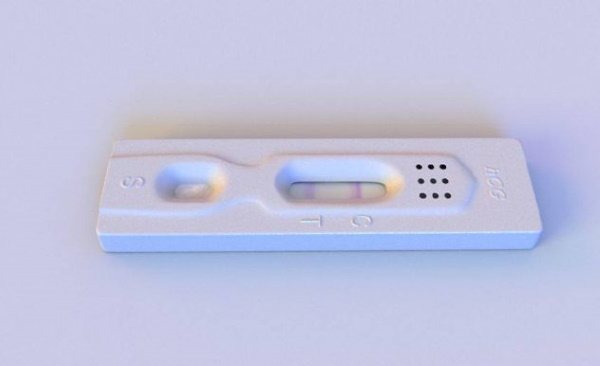
The reagent on a tablet-type pregnancy test (photos with false and questionable results of this type of test are presented later in the article) can also appear, but this happens less often, since these tests are more expensive and manufacturers care more about their quality.
To minimize the appearance of reagents and erroneous results in many tests of this type, the volume of the required amount of liquid (urine) is strictly dosed using the supplied pipette, and the area where the urine directly enters is limited by a special window. Also, most tests of this type include a clean container for collecting biomaterial.
Jet
Perhaps the simplest and most convenient to use are inkjet tests. For pregnancy detection products of this type, there is no need to collect urine in separate containers or use a pipette - you just need to place the test under the stream while urinating for 10-15 seconds. and then evaluate the result after the time specified in the instructions. Outwardly, such tests resemble tablet tests - the strip with the reagent is enclosed in a plastic case, but it is much easier to use, which allows you to quickly find out the result, if necessary, not only at home.
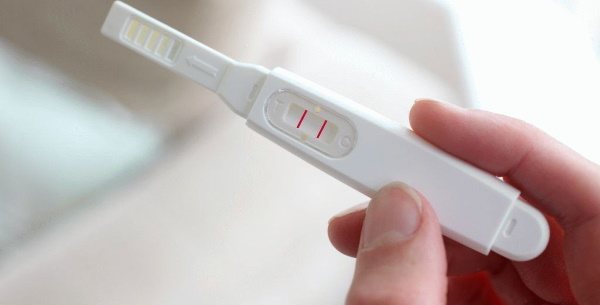
Also, these types of tests are characterized by the highest sensitivity and are able to determine pregnancy 5-7 days before the expected menstruation. In the description of such tests, manufacturers indicate that they are ultra-or supersensitive and determine the level of the hCG hormone in the blood even at its very low concentration.
How does the reagent manifest itself?
The principle of operation of all of the above tests is the same - when urine gets on part of the strip soaked in the reagent, the reagent begins to appear in the form of dark red stripes. If there is pregnancy, then 2 stripes appear, and if there is no pregnancy, then only one control strip. This technique is based on determining the presence of an increased level of hCG in the blood and is visually expressed in the fact that when these antibodies interact with a chemical indicator, the bands become colored.
In modern, even simple tests, in the presence of pregnancy, the second line appears very quickly, sometimes even faster than the control line, which is always present. However, in some simple strip tests, a reagent may appear in place of the strip indicating pregnancy, misleading girls and women.
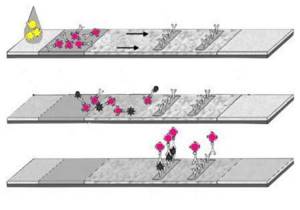
Pregnancy test reagent. The photo shows how the test works.
This streak may appear slightly gray or pinkish and may change color as it dries. As a rule, it is very pale and barely noticeable. Sometimes some girls may take this result as a positive confirmation of pregnancy, which is not always true.
The reagent especially often gives a false positive result when using tests in the cheapest price segment.
Features of use
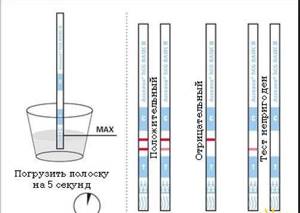
It is very important to know how to use a pregnancy test correctly, since the reliability of the result depends on this. Even when using the most expensive text, one wrong action will lead to a false result.
Before you begin the diagnosis, read the instructions, which indicate how to use the pregnancy test. Often this procedure is the same for all tests. First, you should open the sealed package; you should not touch the test strip with reagents with your fingers. Next, you should ensure that the urine comes into contact with the reagent and wait until the result appears.
Before use, be sure to make sure that the packaging is sealed and the expiration date is correct. It is also important to respect the time frame. If the period is short, then two lines on the test may be very weak. But even if the second line is very weak, but it is present, you should definitely consult a doctor.
Decoding a questionable result
Pregnancy diagnostic products may sometimes give an indeterminate result. The second stripe may be blurry , pink, or one and a half stripes may form. The reasons for this phenomenon are as follows:
- hCG level is very low;
- the level of the hormone is borderline with minimal;
- the test is expired;
- failure to follow instructions for use;
- the woman really wants to see the coveted two stripes.
Sensitivity of pregnancy tests
The sensitivity of pregnancy tests is determined in mIU/ml. Different companies produce pregnancy tests of varying sensitivity.
| Ultra sensitive | They have a sensitivity of 10-15 mIU/ml. Such tests allow you to determine fertilization 5-7 days before the delay or 6-8 days after ovulation and expected conception. |
| Medium sensitive | Pregnancy is determined when the concentration of the hCG hormone is from 20 to 30 mIU/ml. Most tests for determining pregnancy from various manufacturers have these indicators. They are designed to determine pregnancy from the 1st day of missed menstruation. |
Most often you can find tests on sale with an hCG susceptibility indicator of 25 mIU/ml. This is due to the fact that by the time the delay occurs, the concentration of this hormone in the bloodstream just exceeds this indicator. When purchasing a pregnancy test, you should pay attention to its sensitivity and type. Conventional test strips have low sensitivity. They show pregnancy no earlier than 2 weeks after conception.
Tablet-type tests have average sensitivity and can be informative until a delay, but modern inkjet tests, which are capable of recording even minor levels of the hCG hormone in the blood (from 10 mIU/ml), have the greatest sensitivity.
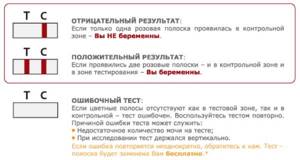
When testing, it is important to know that the hCG hormone does not appear in the blood and urine immediately after the moment of conception (the actual fusion of male and female reproductive cells) and not even immediately after the successful implantation of the fertilized egg into the uterine cavity, but begins to form 2 days after this. That is why carrying out pregnancy testing before 7 days after the expected conception does not make sense.
Can a test fail to show pregnancy?
Manufacturers of the most accurate and sensitive products provide a 99% guarantee, leaving 1% error. They allow for the possibility of errors due to violation of storage conditions, expiration date, sensitivity of the reagent and other factors.
Erroneous data can be shown either by the most expensive and advertised product, which has many good reviews, or by the most affordable one. Some manufacturers claim that their products are highly sensitive and detect pregnancy as low as 10 mIU/ml.
In fact, the test can really “catch” gonadotropin in urine when its amount is not less than 20-25 mIU/ml.
What does a used test strip look like if you are pregnant?
If pregnancy is present, the test confirms this fact by the appearance of 2 red lines on the strip at once: in the test and control zones. The stripe, which confirms the fact of pregnancy, can be either very weak and light pink, or brighter, which depends on the gestational age and the level of concentration of the hCG hormone in the bloodstream. If a woman uses a more advanced version of the test (digital), then a “+” sign or the word “pregnant” will appear in the control zone, and the due date may also be indicated.
When using conventional test strips, carrying out the procedure every other day, you can track the dynamics of the change in color saturation of the 2nd strip, which will become brighter each time. This indicates that the level of the hCG hormone in the blood increases and pregnancy develops without pathology.
Traditional methods for determining pregnancy
Some women use traditional methods to understand their situation, but they cannot give an exact guarantee that the result is determined correctly. The most popular folk method is to collect some urine from the supposedly pregnant woman and drop a little iodine into it. If the drop remains on the surface, then the result is negative, but if it spreads, then the result is positive.
There is also a version that a pregnant woman's urine will be dark yellow. Lovers of traditional methods also combine urine and wine in equal proportions. If the urine remains clear, then pregnancy is present.
An interesting method for determining a woman's position is to plant two onions in a glass of water. One of the glasses symbolizes pregnancy, and the second its absence. In which glass will the onion feathers grow 4 cm faster, this will be the answer.
How to distinguish the reagent from the second strip?
The reagent on a pregnancy test can mislead a woman. Photos of such ghost stripes can be found on many women's forums.
Indeed, in the early stages, especially when testing before a delay, tests can produce weakly positive results, which should not be confused with the reagent:
- the reagent appears in the place where there should be a strip during pregnancy, but it remains white;
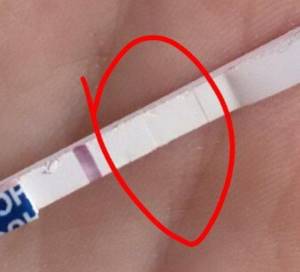
- sometimes the reagent may spread in an uneven pink spot across the strip;
- the reagent may also be gray in color;
- even the weakest strip will be vaguely similar to the control strip, in contrast to the reagent, which has a completely different tone;
- if you repeat the test the next day, the real line will become brighter, which will indicate pregnancy, but if it was a reagent, then the line will not become brighter.
What determines the accuracy of the test?
In order to avoid false results when carrying out the procedure for determining pregnancy at home using tests, it is important to follow certain rules:
- the test should be removed from the sealed package immediately before the manipulation;
- the container for collecting biomaterial must be clean and dry (it is better if it is a pharmaceutical container);
- when immersing the dough in the collected urine, it should be kept in it for the specified amount of time so that it can be sufficiently saturated;
- urine should not in any way come into contact with the area where the results are reflected;
- the use of diuretics (medicines or herbs) or excessive fluid intake may affect the test results, since in this case the urine will be very dilute and the concentration of the hCG hormone will be lower;
- testing is most effective after waking up in the morning, since more of the hormone is concentrated in the urine during the night;
- You should be aware that tests have expiration dates, and using an expired test may affect the result.
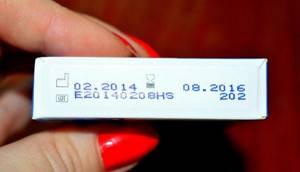
The result should be assessed after the time specified in the instructions - usually from 3 to 10 minutes. In general, self-use of rapid tests usually does not cause difficulties for most women and helps them reliably find out about pregnancy in 98% of cases.
Time spending
In some cases, the effectiveness of the diagnosis may depend on what time the test was taken. Please note that the hCG hormone appears in the urine only on days 7-10. Therefore, you can find out about pregnancy only a week after intercourse.
The amount of hCG hormone begins to increase over time. Therefore, at an early stage, the test may show an erroneous negative result , since the concentration of the hormone will be very small.
It is best to use a highly sensitive jet test a few days before the expected menstruation, and cheaper options should be used only after the first day of the delay. To fully verify the result, you should use several products with an interval of several days.
What does a weak second line mean?
Sometimes when testing, a fuzzy second line appears in the test area. If this streak is not a reagent, which usually spreads or turns gray after drying, then most often it indicates that new life has arisen inside the woman. In this case, you should repeat the test the next day - it should become brighter and the strip itself will be visible more clearly. If there is no dynamics, you should consult a doctor, as this may be a sign of an ectopic or non-developing pregnancy.
Also, sometimes a positive pregnancy test with faint stripes can be associated with certain diseases of the internal female genital organs (ovaries or uterus), in which the hCG hormone is also released.
Modern pregnancy tests allow women to find out about their condition very early, even before a delay occurs. Any woman can find a lot of information on the Internet about how to perform the test correctly, how the reagent behaves under the influence of the hCG hormone, and what photos of positive tests look like. However, despite the fact that the accuracy of tests today is very high, only an ultrasound and blood test can definitively confirm pregnancy.
What to do if the second stripe is pale
When testing at home, you should understand that only a doctor can give the most reliable result. Despite all the assurances from test manufacturers that their systems are 100% accurate, the risk of error is always present. Therefore, if a woman sees a weak line on two tests in a row, she should definitely contact a specialist.
Most likely, after examining the gynecologist, the doctor will offer the woman the following research options:
- Donating blood for hCG.
It is known that after pregnancy, hCG can be detected in the blood much earlier than in the urine. Therefore, a blood test even in the early stages of pregnancy will provide correct data on the woman’s condition. A blood test will be 100% informative already on the first day of missed menstruation. Based on the level of hCG in the blood, one can make an assumption about how far along a woman is. Blood sampling is carried out on an empty stomach in the morning.
- Ultrasound.
The doctor can detect the fertilized egg using transvaginal ultrasound examination on the 5-6th day of missed menstruation. By the transabdominal method, that is, through the abdomen, pregnancy can be diagnosed from 7-8 weeks of intrauterine life of the embryo. As a rule, at such early stages an ultrasound is performed if there is a suspicion that the fertilized egg has settled in the wrong place, that is, an ectopic pregnancy has occurred.
- Examination on a gynecological chair.
Through examination, the doctor can diagnose a pregnancy that occurred no earlier than 4 weeks ago. During a vaginal examination, the doctor will find a engorged cervix and a slightly elongated vaginal vault. The uterus itself will increase in size.
- In case of absence of pregnancy
and the presence of pathologies, the doctor, if necessary, will refer the woman for consultation to other specialists.
So, when receiving an unclear pregnancy test result, a woman’s first step should be to purchase a new device and repeat the study. If the line on the test turns pale again, you should consult a gynecologist.
Author of the article:
Education: Diploma in Obstetrics and Gynecology received from the Russian State Medical University of the Federal Agency for Health and Social Development (2010). In 2013, she completed her postgraduate studies at NIMU named after. N.I. Pirogova.
‹
100% treatment of stage 4 cancer - modern advances in medicine!
Effective remedies and masks for hair loss (home recipes)
›






